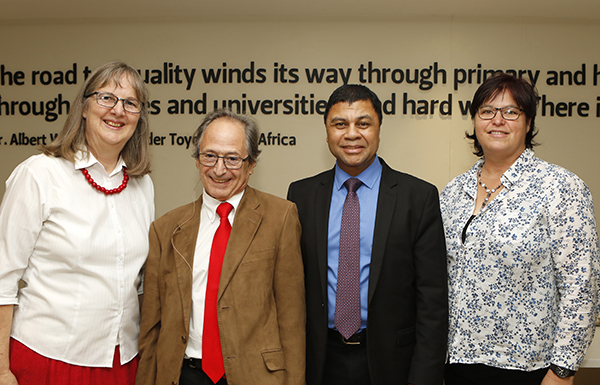Nobel Prize-winner presents first lecture at Vice-Chancellor’s prestige lecture series

At the first lecture in the UFS Vice Chancellor’s Prestige Lecture series,
were from the left: Prof Jeanette Conradie, UFS Department of Chemistry;
Prof Michael Levitt, Nobel Prize-winner in Chemistry, biophysicist and
professor in structural biology at Stanford University; Prof Francis Petersen,
UFS Vice-Chancellor and Rector; and Prof Corli Witthuhn,
UFS Vice-Rector: Research.
Photo: Johan Roux
South African born biophysicist and Nobel Prize-winner in Chemistry, Prof Michael Levitt, paid a visit to the University of the Free Sate (UFS) as part of the Academy of Science of South Africa’s (ASSAf) Distinguished Visiting Scholars’ Programme.
Early this week the professor in structural biology at Stanford University in the US presented a captivating lecture on the Bloemfontein Campus on his lifetime’s work that earned him the Nobel Prize in 2013. His lecture launched the UFS Vice-Chancellor’s Prestige Lecture series, aimed at knowledge sharing within, and beyond our university boundaries.
Prof Levitt was one of the first researchers to conduct molecular dynamics simulations of DNA and proteins and developed the first software for this purpose. He received the prize for Chemistry, together with Martin Karplus and Arieh Warshel, “for the development of multiscale models for complex chemical systems”.
Attending the lecture were members of UFS management, academic staff from a range of faculties and other universities as well as young researchers. “Multiscale modelling is very much based on something that makes common sense,” Prof Levitt explained. “And that is to makes things as simple as possible, but not simpler. Everything needs to have the right level of simplicity, that is not too simple, but not too complicated.”
An incredible mind
Prof Levitt enrolled for applied mathematics at the University of Pretoria at the age of 15. He visited his uncle and aunt in London after his first-year exams, and decided to stay on because they had a television, he claims. A series on molecular biology broadcast on BBC, sparked an interest that would lead Prof Levitt via Israel, and Cambridge, to the Nobel Prize stage – all of which turned out to be vital building blocks for his research career.
Technology to the rescue
The first small protein model that Prof Levitt built was the size of a room. But that exercise led to the birth of multiscale modelling of macromolecules. For the man on the street, that translates to computerised models used to simulate protein action, and reaction. With some adaptations, the effect of medication can be simulated on human protein in a virtual world.
“I was lucky to stand on the shoulder of giants,” he says about his accomplishments, and urges the young to be good and kind. “Be passionate about what you do, be persistent, and be original,” he advised.